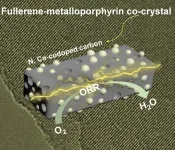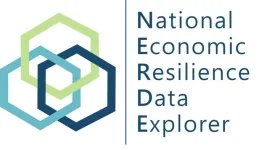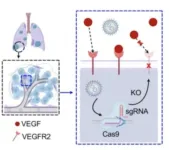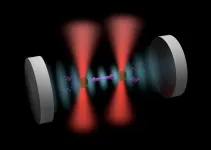(Press-News.org)
Zinc-air batteries are an inexpensive, powerful battery alternative that can be used on the small scale to power electronics or on the large scale for electric vehicles or energy storage. These batteries work when oxygen from the air oxidizes zinc, but the difficulty in oxygen activation which degrades battery performance has prevented their wide commercial adoption.
Information presented in a paper published in Carbon Future on 19 January shows how fullerene- metalloporphyrin derived carbon materials as catalysts can improve the performance and stability of zinc-air batteries.
“The sluggish kinetic characteristics caused by the difficulty in oxygen activation, oxygen to oxygen bond cleavage, and oxide removal of oxygen reduction in zinc-air batteries have limited their application in the commercial field,” said Fang-Fang Li, a professor at the School of Materials Science and Engineering at Huazhong University of Science and Technology in Wuhan, China. “Carbon-based non-noble metallic catalysts have been regarded as promising materials for oxygen reduction reaction due to their large surface areas, high electrical conductivity, outstanding mechanical properties, and excellent stability in electrochemical environments.”
Fullerene is an allotrope of carbon with a closed cage structure in the shape of a soccer ball. Fullerene crystals are created through a process called liquid-liquid interface precipitation. During this process, fullerene and active organic cobalt-metalloporphyrin are dissolved in a good solvent and then precipitate from the mixed solution when a poor solvent is added to the good solvent, thus obtaining the fullerene-metalloporphyrin cocrystal. Researchers created four versions of Co, N co-doped carbons using the cocrystal as the precursor to seek the best performance. Three were heated to different temperatures (700°C, 800°C, and 900°C) and then the final sample was also heated to 800°C, but mixed differently from the other samples without the liquid-liquid interface precipitation method.
Before testing the performance of the fullerene-metalloporphyrin cocrystal and its derived Co, N codoped carbons, researchers studied the structural features of the samples through scanning electron microscopy and X-ray diffraction, Raman spectroscopy, and additional measurements. They found that the liquid-liquid interface precipitation method increased defects, which improved the performance of the oxygen reduction reaction. They also consistently found that the co-crystal heated to 800°C performed better than the others tested throughout the experiment.
To test the performance of the fullerene-metalloporphyrin cocrystal derived Co, N codoped carbons, researchers built a homemade zinc-air battery, using the Co, N codoped carbons as the cathode. “The results highlight the exceptional long-term stability exhibited by Co, N codoped carbons. The optimized zinc-air battery performance of Co, N codoped carbons underscores the robust and enduring electrocatalytic performance. This combination of high power density and extended stability positions fullerene-metalloporphyrin cocrystal derived d Co, N codoped carbons as a highly promising catalyst for practical applications of zinc-air batteries,” said Li.
Other contributors include Ao Yu, Qi Huang, Shixin Gao, Tingting Xu, and Ping Peng at Huazhong University of Science and Technology and Wei Zhang, Nimanyu Joshi, and Yang Yang at University of Central Florida.
The National Natural Science Foundation of China supported this research.
About Carbon Future
Carbon Future is an open access, peer-reviewed and international interdisciplinary journal that reports carbon-related materials and processes, including catalysis, energy conversion and storage, as well as low carbon emission process and engineering. Carbon Future will publish Research Articles, Reviews, Minireviews, Highlights, Perspectives, and News and Views from all aspects concerned with carbon. Carbon Future will publish articles that focus on, but not limited to, the following areas: carbon-related or -derived materials, carbon-related catalysis and fundamentals, low carbon-related energy conversion and storage, low carbon emission chemical processes.
About SciOpen
SciOpen is a professional open access resource for discovery of scientific and technical content published by the Tsinghua University Press and its publishing partners, providing the scholarly publishing community with innovative technology and market-leading capabilities. SciOpen provides end-to-end services across manuscript submission, peer review, content hosting, analytics, and identity management and expert advice to ensure each journal’s development by offering a range of options across all functions as Journal Layout, Production Services, Editorial Services, Marketing and Promotions, Online Functionality, etc. By digitalizing the publishing process, SciOpen widens the reach, deepens the impact, and accelerates the exchange of ideas.
END
Highlights:
A chemical called Bisphenol A (BPA) is used to make many durable plastics and resins.
Previous studies suggest high BPA exposure can increase health risks and change gut microbiome structure.
Researchers investigated links between BPA exposure, obesity and the gut microbiome.
The study found that normal-weight children had more unique bacteria taxa, which may help degrade BPA.
The findings may help point to microbial strains that neutralize BPA in the gut.
Washington, D.C. — March 1, 2024 — A synthetic chemical called Bisphenol A, or BPA, is widely used in the production of durable plastic products including eyewear, ...
Community leaders and administrators now have a more powerful tool for understanding their communities’ economic strengths and vulnerabilities, thanks to the newly enhanced and cleverly monikered National Economic Resilience Data Explorer (NERDE). The online data portal’s enhanced second edition makes it easier for users to create economic development plans, improve resilience and apply for economic assistance and grants.
NERDE first launched as a partnership between the U.S. Department of Energy’s (DOE) Argonne National ...
The most recent COVID-19 booster shot reduces adults’ risk of moderate or severe COVID by more than half, according to a new nationwide data study from September 2023 through January 2024, a period of JN.1 variant dominance.
The new study is one of the first to evaluate protection provided by the updated shot against COVID-19-associated emergency department and urgent care visits (markers for moderate disease) and against hospitalizations (a marker for severe disease), in individuals 18 and older, due to JN.1, the most ...
Mendelian randomization, a powerful tool in medical research, helps us understand whether certain factors truly cause disease. This technique uses genetic variations as "natural experiments" to reveal cause-and-effect relationships. However, choosing the proper genetic variations is crucial for accurate results.
Think of a train network where the genetic variation is the starting point, the exposure is a station, and the disease is the destination. The train must pass through the exposure station en route to the disease. This represents the critical assumption of Mendelian randomization: ...
Penn Engineers have developed a new means of targeting the lungs with lipid nanoparticles (LNPs), the miniscule capsules used by the Moderna and Pfizer-BioNTech COVID-19 vaccines to deliver mRNA, opening the door to novel treatments for pulmonary diseases like cystic fibrosis.
In a paper in Nature Communications, Michael J. Mitchell, Associate Professor in the Department of Bioengineering, demonstrates a new method for efficiently determining which LNPs are likely to bind to the lungs, rather than the liver. “The way the liver is designed,” says Mitchell, “LNPs tend to filter into hepatic cells, and struggle ...
The question of where the boundary between classical and quantum physics lies is one of the longest-standing pursuits of modern scientific research and in new research published today, scientists demonstrate a novel platform that could help us find an answer.
The laws of quantum physics govern the behaviour of particles at miniscule scales, leading to phenomena such as quantum entanglement, where the properties of entangled particles become inextricably linked in ways that cannot be explained by classical physics.
Research in quantum physics ...
New findings reveal that the body undergoes significant, systematic changes across multiple organs during prolonged periods of fasting. The results demonstrate evidence of health benefits beyond weight loss, but also show that any potentially health-altering changes appear to occur only after three days without food.
The study, published today in Nature Metabolism, advances our understanding of what’s happening across the body after prolonged periods without food.
By identifying the potential health benefits from fasting ...
The microbiome can identify those who benefit from combination immunotherapy across multiple different cancers, including rare gynaecological cancers, biliary tract cancers and melanoma.
Researchers from the Wellcome Sanger Institute, the Olivia Newton-John Cancer Research Institute in Australia, and collaborators, have identified specific strains of bacteria that are linked with a positive response to combination immunotherapy in the largest study of its kind.
The study, published today (1 March) in Nature Medicine, details a signature collection of microorganisms in an individual’s gut bacteria that may help identify those who would benefit from combination immunotherapy and ...
A study published today in Nature Nanotechnology shows that similarly charged particles can sometimes attract, rather than repel.
The team found that like-charged particles suspended in liquids can attract one another at long-range, depending on the solvent and the sign of the charge.
The study has immediate implications for processes that involve interactions in solution across various length-scales, including self-assembly, crystallisation, and phase separation.
‘Opposites charges attract; like charges repel’ is a fundamental principle of basic physics. But a new study from Oxford University, published today in Nature Nanotechnology, has demonstrated that similarly ...
In this study, we determined nine genomes of Japanese wolves and 11 genomes of modern Japanese dogs at high coverage and analyzed with one hundred dog and wolf genomes in the public database. The analyses showed that 1) the Japanese wolf was a unique subspecies of the gray wolf that is genetically distinct from both extant and ancient gray wolves known to date, 2) the Japanese wolf is most closely related to the monophyletic group of dogs. Furthermore, 3) Japanese wolf ancestry has introgressed into the ancestor of East Eurasian dogs at an early stage of the dog’s history ...








